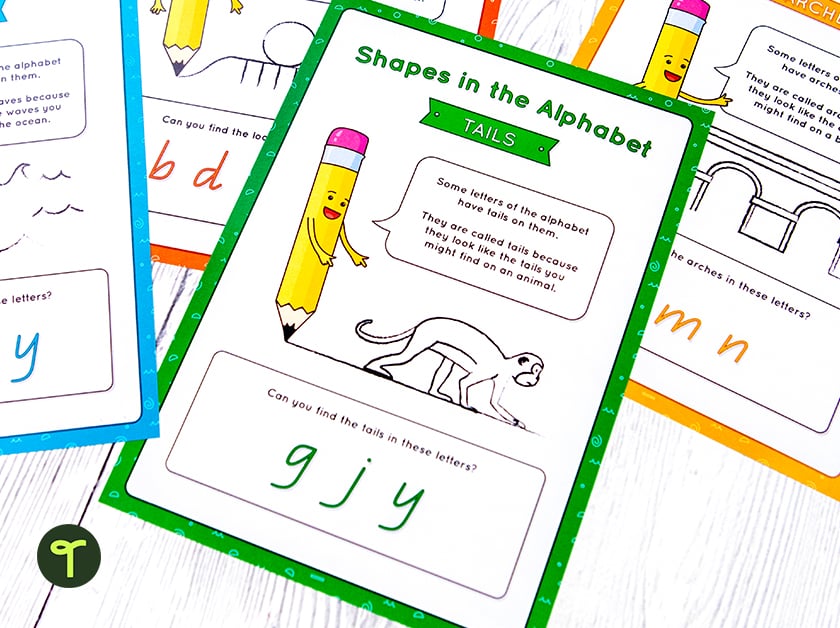Are you teaching handwriting this school year? The main building blocks for teaching handwriting in the primary grades include developing your students’ pre-writing and fine motor skills, encouraging the crossing of the midline, correct pencil grip, strong pencil control, and an understanding of letter patterns and letter formations.
To help you teach handwriting, our team of expert teachers have put together our favorite tips and ideas to make teaching handwriting easier on you and your students too. Get ready to hit the “bookmark” button, because these tips are crucial for a good teacher toolkit!
Why Is Teaching Handwriting Important?
In a day and age when just about every student has a digital device, is teaching handwriting really all that important? It turns out the act of handwriting actually activates sections of the brain, which scientists tell us support students as they develop their literacy skills, including their understanding of sight words and spelling. And for students who aren’t adept at handwriting, stress over how to make things legible can prevent them from getting their ideas out on paper.
Try these sight word resources for early readers!
[resource:4821346] [resource:4802110] [resource:4798686]
Of course, handwriting doesn’t necessarily come naturally. It’s estimated that anywhere from 10 to 30 percent of elementary school students struggle with handwriting. That’s where these ideas on teaching handwriting from the team of teachers creating Teach Starter’s resources can help!
Teaching Handwriting Through Prewriting Activities
Prewriting activities are the basis for developing a strong pencil grip. There are a plethora of prewriting activities that you can incorporate into your classroom today when teaching handwriting. These activities will help develop and set your students up for success as they transition from the emergent writing stage.
(1) Develop Fine Motor Skills
Developing your students’ fine motor control is fundamental in any Pre-K and Kindergarten classroom. Fine motor development can be incorporated into a variety of activities. There are many printable resources available in our fine motor teaching resources collection. Other ideas include:
- Playing with playdough to strengthen students’ fingers and hands.
- Lacing and threading activities to develop hand-eye coordination.
- Cutting activities with scissors to strengthen hands.
- Open and closing activities such as using clothespins on clip card activities.
Check out some of our printable fine motor resources for the classroom:
[resource:4686994] [resource:2670294] [resource:4174506]
(2) Incorporate Crossing the Midline Activities
Crossing the midline is a slightly different skill your students will need to develop as they develop their handwriting.
A child that has established this skill will be able to cross a body part (e.g. hand or foot) over to the other side of the body with ease. Sounds simple, doesn’t it? But, for the little learners in your classroom who are still developing this skill, simple things such as tracing, cutting, or even beginning to write may get tricky.
(3) Pencil Grasp Training
A good pencil grip or pencil grasp will allow your students to keep the wrist steady and make small movements of the fingers to create short straight and curved lines.
What do I do if a student is holding their pencil incorrectly? Changing a student’s pencil grip is very difficult, and many people ask if it is worth trying to fix it? It’s best to check with your school occupational therapist for an evaluation if you’re worried about a student’s grasp. Most research indicates it’s more important to focus on a child’s handwriting speed and letter formation than on pencil grasp pattern.
Try these pencil grip resources!
[resource:2651354] [resource:2651354] [resource:65445]
(4) Practice Pencil Control
Apart from helping with fine motor, tracing activities like these animal-inspired Prewriting Pencil Control Tracing sheets are fantastic to focus your students on pencil control.
Here are some printable pencil control tracing worksheets that would work beautifully!
[resource:2652862] [resource:177926] [resource:4286406]
[resource:4517823] [resource:175127] [resource:4139650]
Letter Formation Activities and Resources
Learning to form letters correctly is another massive part of the handwriting process. It’s important to incorporate many opportunities for your students to learn correct letter formation from the very beginning. Here are some printable resources that will assist you in this process.
(1) Shapes in the Alphabet
Students’ understanding that specific shapes can be found in the alphabet letters is an excellent way to begin the transition from prewriting pattern activities into understanding the letters’ formation. This set of Shapes in the Alphabet posters is the perfect supplement when teaching handwriting to explain how certain shapes can be found in the alphabet such as loops, waves, tails, and arches.
(2) Letter Formation Posters
Along with the shapes of the letters, teaching handwriting can be supplemented by Letter Formation Alphabet Posters that serve as a good visual reference for students. Each of the posters also includes simple instructions to help students understand how each letter is formed.
(3) Letter Formation Task Cards
This set of Lowercase Letter Formation Task Cards is handy when teaching handwriting. They help younger students to learn the basic formation of lowercase letters.
Teach Starter Teacher Tip: Punch a hole in the corner of your task cards, add a binder ring, and these cards are ready to use in your writing centers!
(4) Word Shape Activities
When students are further along in their handwriting journey, focusing on looking at word shapes is beneficial for them to understand how letters look in simple CVC words. It’s also a great way to build word and letter recognition. This resource is a set of CVC Word Shape task cards perfect for a reading center.
Explore handwriting resources and thousands more teaching resources created by teachers to save you time!
Banner image via Shutterstock/spass








Comments